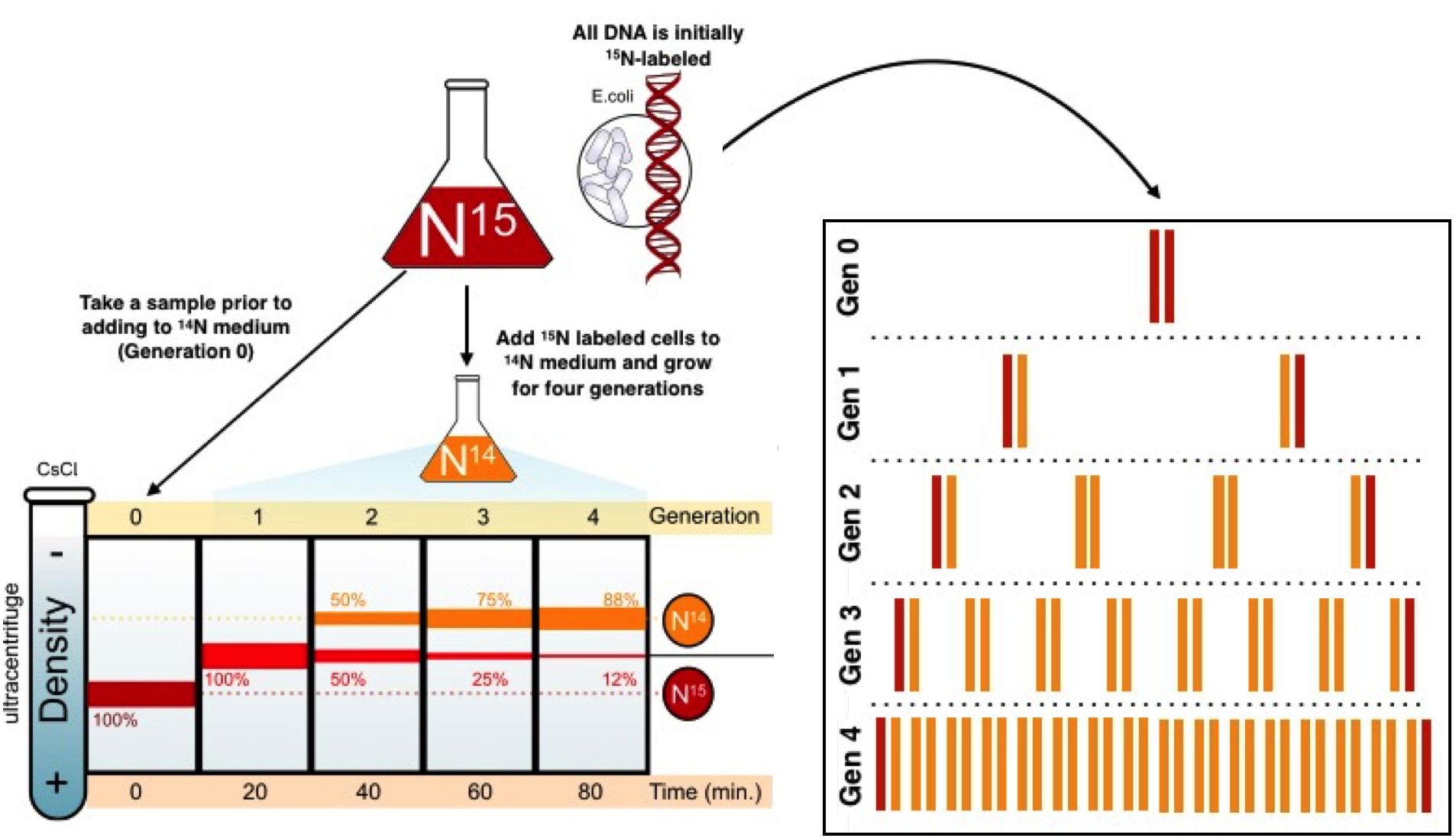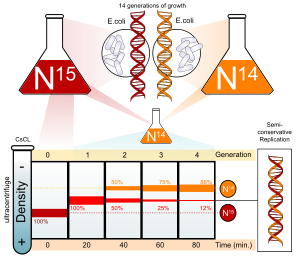The Meselson and Stahl Experiments Supported This Method of Replication.
The beauty of this experiment was that it allowed them to distinguish between the three different hypothesized replication patterns. Which of the following processes can be referred to as Semiconservative.

The Meselson Stahl Experiment 1957 1958 By Matthew Meselson And Franklin Stahl The Embryo Project Encyclopedia
The collaboration among scientists that ultimately produced concrete evidence of.

. The following represent steps in the process of DNA replication by telomerase. In 1957 two young scientists Matthew Meselson and Frank Stahl produced a landmark experiment confirming that DNA replicates as predicted by the double helix structure Watson and Crick had recently proposed. Meselson Stahl reasoned that these experiments showed that DNA replication was semi-conservative.
The MeselsonStahl experiment is an experiment by Matthew Meselson and Franklin Stahl in 1958 which supported Watson and Cricks hypothesis that DNA replication was semiconservative. Meselson and Stahl experiment1958 supported Watson and Cricks hypothesis that DNA replication was semiconservativebardhansbiology. The key result occurs at the second generation when all three proposed.
The DNA strands separate and each makes a copy of itself so that each daughter molecule comprises one old and one new strand. Matthew Meselson and Franklin Stahl have used Ecoli as the Model organism to explain the semiconservative mode of replication. This module explores the research methods used by Meselson and Stahl in their ingenious 1958 experiment showing how DNA replicates.
Testing predictions is a major part of scientific research and a key component of many classic experiments. Be specific regarding percent distributions. The Meselson and Stahl experiments supported this method of replication.
Identify the three proposed models for DNA replication. In 1958 Meselson and Stahl conducted an experiment to determine which of the three proposed methods of DNA replication was correct. The Meselson and Stahl experiments supported this method of replication.
Bacteria grown in heavy Nitrogen have been labeled on both strands entirely with heavy Nitrogen. Semiconservative replication means that when the double stranded DNA helix was replicated each of the two double stranded DNA helices consisted of one strand coming from the original. Meselson a graduate student and Stahl a postdoctoral researcher both at the California Institute of Technology Pasadena gave validity to a model that many scientists saw as speculation.
It also gained immediate renown as a most beautiful experiment whose beauty was tied to its simplicity. Arrange them in the right order with the. It is an experiment by Matthew Meselson and Franklin Stahl in 1958 which supported Watson and Cricks hypothesis that DNA replication was semiconservative.
In semiconservative replication when the double stranded DNA helix is replicated each of the two new double-stranded DNA helices consisted of one strand from the original helix and one. Matthew Meselson and Franklin Stahl conducted the Meselson-Stahl experiment which returned results that supported the semi-conservative theory of DNA replication. Matthew Meselson and Franklin Stahls experiments on the replication of DNA published in PNAS in 1958 2 helped cement the concept of the double helix.
What results would you predict to observe after two rounds of replication. The module highlights the power of simplicity in what has been called the most beautiful experiment in biology. The researchers were confused.
The MeselsonStahl experiment is an experiment by Matthew Meselson and Franklin Stahl in 1958 which supported Watson and Cricks hypothesis that DNA replication was semiconservative. Biology questions and answers. The MeselsonStahl experiment was an experiment by Matthew Meselson and Franklin Stahl in 1958 which supported the hypothesis that DNA replication was semiconservative.
Matthew Meselson and Franklin Stahl are famous for their DNA replication experiment. The Meselson and Stahl Experiment This is an experiment by Matthew Meselson and Franklin Stahl in 1958 which supported the hypothesis that DNA replication was semi conservative. In semiconservative replication when the double stranded DNA helix is replicated each of the two new double-stranded DNA helixes consisted of one strand from the.
In the past there were three models for how organisms might replicate their DNA. There are three modes of replication introduced during the 1950s like conservative semi-conservative and dispersive. Semi-conservative conservative and dispersive.
Conservative Semiconservative Dispersive Anwer Bank A. CONCLUSION The experiment done by Meselson and Stahl demonstrated that DNA replicated semi-conservatively meaning that each strand in a DNA molecule serves as a template for synthesis of a new complementary strand. Avery MacLeod and McCarthy c.
Semiconservative The ability to predict the DNA sequence in one strand based. It was introduced by the Matthew Meselson and Franklin Stahl in the year 1958. The purpose of the experiment was to provide an explanation for James Watson and Francis Cricks structure of DNA.
What method proves semi-conservative replication. By spinning DNA extracted at different times during the experiment Meselson and Stahl were able to see how new and old DNA interacted during each round of replication. Meselson and Stahl conducted the experiment which supported the hypothesis made by Watson and Crick that DNA replicates.
Hershey and Chase. Imagine the Meselson and Stahl experiments had supported conservative replication instead of semiconservative replication. Meselson and Stahl b.

Meselson Stahl Experiment Wikiwand

Mode Of Dna Replication Meselson Stahl Experiment Article Khan Academy

Comments
Post a Comment